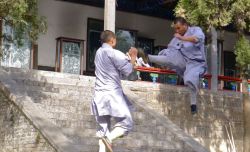Deng Feng, a small town by Chinese standards and a home to Shaolin Temple, makes an impression of a place from the Shaolin Soccer universe. There are numerous kung-fu and wushu schools in town and it seems that everyone is involved in some sort of a martial art here. Shaolin Temple itself is a very tourist oriented place which is reflected on a steep entrance fee (100Y). Upon arriving into the town I met this local kung-fu / tai chi practioner, whom I taught a couple of capoeira tricks. He, in return, told how to get to the mountain and temple for 2/3 of the price. You go to other side of the mountain and buy a ticket for only the mountain entrance (35Y, not advertised anywhere) and then at the temple pay only for the temple entrance free in form of donation (30Y). Voile, a little saving and great mood for the whole day! Anyways, Shaolin Temple is just another temple, nothing special about it except the hype and all the history. Kung-fu show demonstrated by Shaolin monks was ok, apart from the terrible music and poor coreography. Nice moves, though. On the other hand, supplemental sights as Pagoda Forest, 500 Buddhas Hall and Songshan mountain are magnificent. Songshan is the central mountain out of five Taoist mountains and plays an important role in China’s history for one reason or another. Joseph Campbell with his “every mountain is a central mountain” sprang to mind. No wilderness here, but the hiking infrastructure is impressive. The mountain looks like a civilized park, but on the other hand if not for infrastructure it would be rather difficult to climb the mountain. Had mixed feeling about that one. Shame though that even here up in the mountains you cannot escape the Great Air Pollution Wall of China.
I planned to spend some time to Keifeng the next day and leave to Shanghai by a night-train, but upon arriving there learned that there are tickets only for a day fast train. No Keifeng sightseeing for me, but on the other hand got another chance to feel myself immersed into the futuristic world of Chinese high-speed trains. This one is not as fast as previous one (top speed 200km/h vs 330km/s of the previous one), but I got a soft seat, which is essentially the first class, as China is theoretically a classless society.
